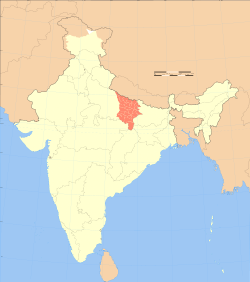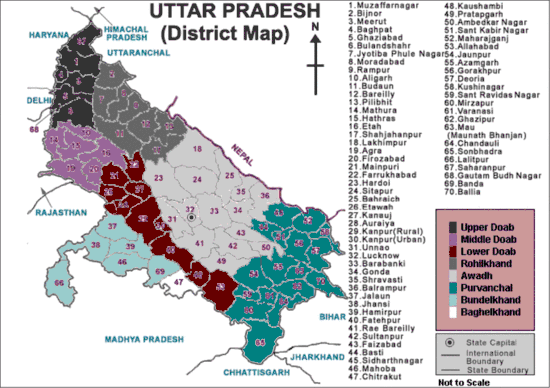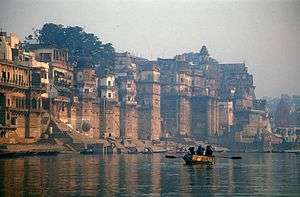Purvanchal
| Puruvanchal | |
|---|---|
| Region | |
 Location of Purvanchal | |
| Country |
|
| Region | Hindi Belt in North India |
| Major Cities | [Ayodhya]], Gorakhpur, Varanasi, Faizabad (East of Sarayu River), Jaunpur, Azamgarh, Mirzapur, Kushinagar, Mughalsarai, Ghazipur, Ballia, Deoria, Kushinagar |
| Language | Bhojpuri and Awadhi dialects of Hindustani |
| Largest district | Sonbhadra |

Purvanchal is a geographic region of northern India, which comprises the eastern end of Uttar Pradesh and western end of Bihar, where Hindi, and its dialect Bhojpuri is the predominant language. It is bounded by Nepal to the north, Indian state Bihar to the east, Bagelkhand region of Madhya Pradesh state to the south, the Awadh region of Uttar Pradesh to the west and the end of Lower Doab (the Kanpur-Fatehpur-Allahabad region) in Uttar Pradesh to its southwest.
Etymology
The name Purvanchal is derived from two hindi word Puruv(East) and Anchal(Region) which means The eastern part of a region or East zone.[1]
Modern Definition
Purvanchal consists primarily of 4 divisions: the eastern Awadhi region in the west, the western Bhojpuri region in the east, the Baghelkhand region in the south, and the Nepal region in the north.
Districts
Purvanchal includes the following 18 districts from Uttar Pradesh[2]
Administrative Divisions.
Geography
It lies on the Indo-Gangetic plain, and together with western Bihar is the most densely populated area in the world. The rich quality of its soil and the high earthworm density in the soil as opposed to adjoining districts of Uttar Pradesh makes the region favourable for agriculture. Most of the countryside is given to intensive agriculture. Bhojpuri is the predominant language or dialect in the region, in addition to Hindi, although Awadhi and Baghelkhandi are also spoken in the western and southern areas. Like Bihar state to the east, a large population, slow economic growth, agricultural mechanisation, and the closure of sugar mills have led to increased unemployment, social and political discontent, and some unrest in the region.
History
Historically Purvanchal is the region ruled by the king of Kashi (Kashi Naresh), which regions are Mirzapur, Chandauli, Ballia, Mau, Ghazipur, Sonbhadra, Deoria, Kushinagar, Azamgarh, Jaunpur, Bhadohi, some parts of Gorakhpur, Basti and also Sant Kabir Nagar.[3] This territory was ruled by the Bhuinhar_Brahmins, which have their strong army to support them.[3] The Kingdom of Kashi was founded by Khsetravridha, the son of Ayus, of the Somavansa dynasty of Pratishthana. It lost independence in 1194 and was eventually ceded by the Nawab of Oudh to the British Raj in 1775, who recognized Benares as a family dominion. Benares became a state in 1911[2]. It was given the privilege of 13-gun salute.
The kingdom of Benares currently known as Varanasi was recaptured from Nawab of Oudh by Mansa Ram, a Gautama clan Bhuinhar_Brahmin zamindar of Utaria.[3] In 1737 AD Balwant Singh, ruler of Utaria, later captured the territories of Jaunpur, Ghazipur, Varanasi and Chunar in 1740 AD from the Mughal Emperor of Delhi.[3] The Kingdom of Benaras started to hold prominence in this way during the Mughal dynasty. Other prominent places under the kingship of Kashi Naresh were Chandauli, Gyanpur, Chakia, Latifshah, Mirzapur, Nandeshwar, Mint House and Vindhyachal.[3]
With the decline of the Mughal Empire, the military of Bhuinhar Brahmins strengthened their sway in the area south of Avadh and in the fertile rice growing areas of Benares, Gorakhpur, Deoria, Ghazipur, and Ballia and on the fringes of Bengal.[3] The strong clan organisation on which they rested, brought success to the lesser Hindu princes. There were as many as 1,00,000 Bhuinhar Brahmin clansmen backing the power of the Benares rajyas in what later became the districts of Benares, Gorakhpur and Azamgarh.[3] This proved a decisive advantage when the dynasty faced a rival and the nominal suzerain, the Nawab of Awadh, in the 1750s and the 1760s.[3] An exhausting guerrilla war, waged by the Benares ruler against the Avadh camp, using his clan troops, forced the Nawab to withdraw his main force.[3]
Culture

Purvanchal is one of the most ancient regions of India and enjoys a rich heritage and culture, particularly because of its association with cities like Varanasi, Gorakhpur etc.
Varanasi is the cultural capital of India. A combination of archaeology, mythology, geography, art and history makes Varanasi a great center of Indian culture. A major religious hub in India, it is the holiest of the seven sacred cities (Sapta Puri) in Hinduism and Jainism, and played an important role in the development of Buddhism. [4]
Education
Banaras Hindu University is a Central University in Purvanchal.[5] It evolved out of the Central Hindu College of Varanasi, set up by Annie Besant — a colorful British woman of Irish descent — who joined hands with Pandit Madan Mohan Malaviya in April 1911 for a common Hindu university at Varanasi.
Indian Institute of Technology (Banaras Hindu University), Varanasi is an Institute of National Importance in Purvanchal. It is one of the 16 prestigious Indian Institutes of Technology. It was established in 1919 by the visionary Mahamana Pandit Mohan Malviya and has been constantly ranked among the top 10 technical institutes of India.
A Government Degree College was set up by the Government of Uttar Pradesh, for providing higher education to scholars who are interested in course work and programs of higher studies. At present, 137[6] Government Degree Colleges have been established by the state government to fulfill above criteria. The UP government[7] administers, manages and controls these colleges through Department of Higher Education, Uttar Pradesh[8] and follows the norms and regulations of University Grants Commission, New Delhi.,[9] National Seed Research and Training Centre, Varanasi,[10] Jamia Salfia Darul-Islamia, islamic University, Varanasi[11]
See also
References
- ↑ http://www.hindi2dictionary.com/%E0%A4%AA%E0%A5%82%E0%A4%B0%E0%A5%8D%E0%A4%B5%E0%A4%BE%E0%A4%82%E0%A4%9A%E0%A4%B2-meaning-hindi.html
- ↑ "Proposed Purvanchal Map". Retrieved 19 June 2016.
- 1 2 3 4 5 6 7 8 9 Bayly, Christopher Alan (1983). Rulers, Townsmen, and Bazaars: North Indian Society in the Age of British Expansion, 1770–1870. Cambridge University Press. p. 489 (at p 18). ISBN 978-0-521-31054-3.
- ↑ http://www.varanasicity.com/arts-crafts-varanasi.html
- ↑ "University at Buffalo, BHU sign exchange programme". Retrieved 19 June 2016.
- ↑ "High Education Department". Retrieved 19 June 2016.
- ↑ http://upgov.nic.in/
- ↑ "Higher Education Department". Retrieved 19 June 2016.
- ↑ http://www.ugc.ac.in/policy/englishgazette.pdf
- ↑ http://www.nsrtc.nic.in/
- ↑ "Al Jamia Tus Salafiah – Varanasi, India". Retrieved 19 June 2016.


